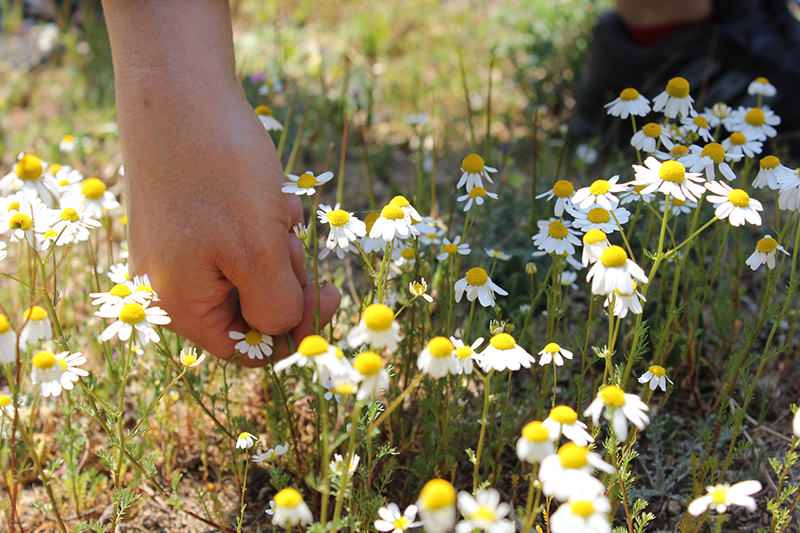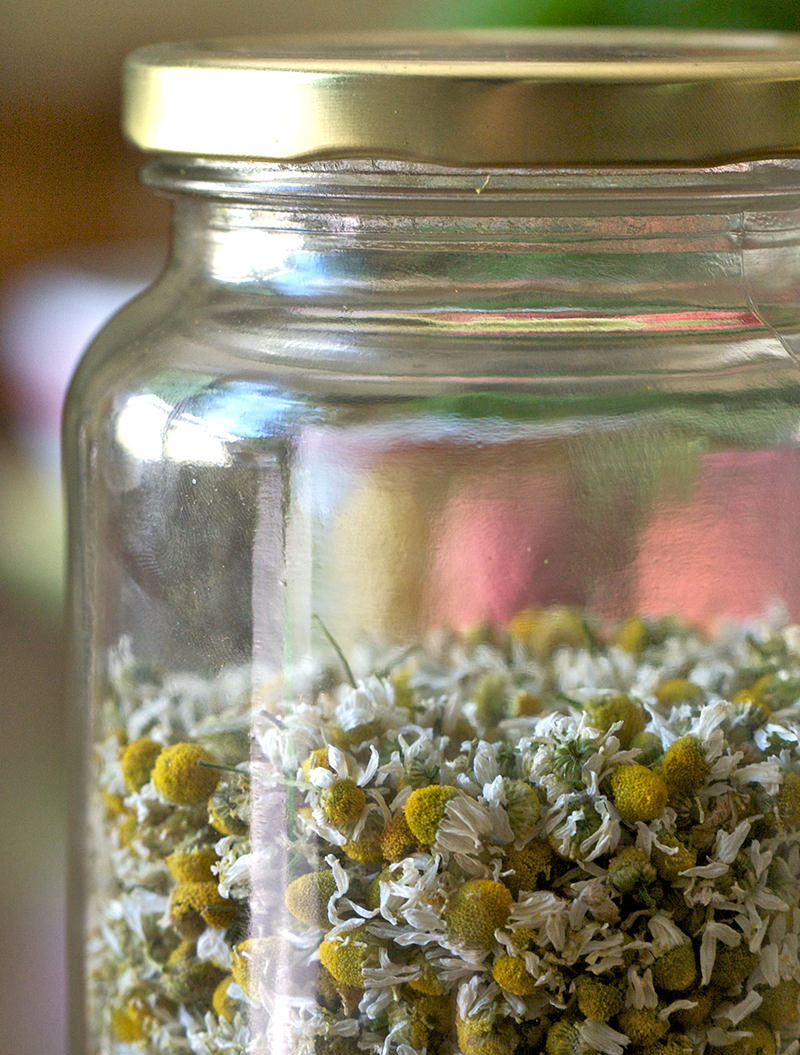
Chamomile is one of those plants in my garden that constantly remind me that the herbs I use for tea can be incredibly gentle and powerfully effective. The delicate blossoms and leaves stand up to the harsh sun of summer and can even be found blooming long after the first frosts of the fall. For all the hardiness of this blossom, it is gentle enough for everyone in the family and is useful in a long list of ailments.
What Is Chamomile?
It’s is a flower in the Asteraceae family, making it a relative of the daisy. It’s characterized by its cheery yellow-and-white flowers and lacy foliage and a pineapple scent. There are two types of you’ll find in herb gardens:
- Roman chamomile (Anthemis nobilis): Typically perceived as the perennial chamomile, Roman chamomile grows low and spreads. It has been used in lawns where people are encouraged to step or sit on the plants. I have found that the bloom of Roman chamomile is larger than German chamomile’s.
- German chamomile (Matricaria recutita): This variety grows taller, is considered the wild variety and tends to be a self-seeding annual. It’s more delicate and less winter-hardy than Roman chamomile.
People often ask me whether there is a difference between the Roman and the German types. They are used interchangeably for the benefits they provide in the human body. Their growth habits are different, though, and you may choose to plant them each in different beds because of that.
Chamomile also has a look-alike called dog fennel (Anthemis cotula). The easiest way to tell the difference is to crush the leaves and flowers between your fingers. The look-alike smells bad, and the real chamomile will remind you of that delicious sleepy-time tea.
When and What to Harvest?

Harvesting chamomile is usually a summer pastime, though if you’re lucky, you may get a few plants that continue to bloom through a frost. Typically, it’s the flowers you’ll harvest for use in teas, though the leaves are also collected in some parts of the world for therapeutic use.
If you keep your patch picked daily, it will continue to bloom all summer. In any given patch, the flowers don’t all bloom at the same time. This is the real challenge of chamomile. Each bloom must be picked at its peak if you want the best benefit and flavor, and this takes a lot of time! Here’s the picking process:
- Start harvesting chamomile flowers in the morning after the dew has evaporated but before the sun is high.
- Select the flowers that are nearly open. Pinch the stalk just below the flower head and pop off the bloom. Collect them in a tightly woven basket.
- The flowers that are done blooming give you an opportunity to collect seeds or allow the plants to self-seed next year’s patch. (Be careful with self-seeding if you like to keep tight control of what grows in your flower beds—it will happily spread everywhere.)
Be aware that there are very rare reports of a topical hypersensitivity to chamomile. The potential pool of folks affected are those who are also allergic to other members of the Asteraceae family, such as ragweed. If you develop a rash while picking chamomile flowers, it is best to avoid using them externally or internally.
Fresh vs. Dried

Once you’ve picked a nice basket of the flowers, it is a huge temptation to head inside and devour them. Go ahead! Chamomile can be used either fresh or dried. I have often heard—though to be honest, I haven’t found anything concrete to back this up—that the beneficial chemicals in the flower develop best during drying, but this does not mean that a fresh tea won’t do you any good.
How to Make Chamomile Tea
Pour 1 cup boiling water over 2 to 3 teaspoons dried chamomile—add more flowers if using fresh. For a light and delicious tea, steep for about 5 minutes. For more medicinal benefits, steep for at least 10 to 15 minutes or even overnight.
How to Dry the Flowers

To dry your chamomile, you’ll need heat and airflow. This might mean you use an oven on the drying setting, a dehydrator, or a small fan in a dark room.
On our farm, we dry our herbs in a barn loft, where we have stretched screening material over wooden frames. Unfortunately, I found that every time I dried the small, delicate flowers, I lost a big part of the harvest through the screen because they shrunk and fell through. To remedy this, I bought a pack of inexpensive white window sheer fabric. When I dry chamomile, I now spread the sheer on top of my screen before I spread the blooms. When everything is dry, I simply pick up the fabric and use it as a funnel into my storage container.
For many who have only bought their own chamomile, it is a surprise that the white petals of the fresh flower should be part of your tea. Commercial chamomile is often so worn out that you only receive the yellow dome. If you are drying your own, you can carefully ensure that all parts of the flower are preserved.
Storing Your Harvest
Store your dried chamomile is in an air-tight glass container. Colored glass is the gold standard, but you may repurpose any size or shape of clear glass container. Keep your jar out of direct heat and light, and it should keep well into the following year’s harvest season.
Uses for Chamomile

You might know chamomile best as an ingredient in sleepy-time tea, but the truth is it can do more than help you get a little shut-eye. Here are some of my favorite uses, for your health and in the garden.
Teething Babies
Chamomile is one of the very best herbs for easing the pain of teething. When my children went through this phase, I soaked a washcloth in chamomile tea and froze it. The resulting teether made a bit of a mess, but nothing that would stain. The relief it gave was worth a soaked shirt.
Anxiety
Chamomile is a gentle nervine, which means that it feeds and tones the nervous system. For anxiety, it has a long track record. In fact, the longer you drink chamomile tea on a daily basis, the more calming you will find it.
Upset Stomach
The digestive benefits of chamomile are one great reason to let your tea steep longer. The bitter compounds found within the plant do not come through until after it has been infusing for longer than your average tea bag. A cup of chamomile tea when your stomach is churning can be just the thing to settle things down, especially when it’s caused by an emotionally difficult day.
Inflammation
In our household, when a mild anti-inflammatory is needed we reach for chamomile. Whether internally or externally, such as in the eyes, a chamomile tea is an easy way to calm and soothe irritated tissues. (However, if you’re sensitive to chamomile, avoid using it for this purpose.)
Hair Rinse
When I was young, I occasionally spent the day in the sun with lemon juice in my hair. I wish I had known that by rinsing my hair with chamomile tea, I could encourage the same light, bright highlights.
A Companion Plant
We grow German chamomile near the cauliflower, broccoli and cabbage in our vegetable garden. It keeps the weeds down between the large brassica plants, and the flowers distract the cabbage moth from munching my favorite vegetables.
With so many great uses for this bright, sunny flower, it’s well worth the time and effort to grow and harvest. The time I spend in the quiet of the garden on a summer day while picking the small blossoms do as much for me as if I were drinking a cup of the tea. We all need more excuses for these times of contemplation and peace. You might say growing chamomile is a way to grow your own meditation.





